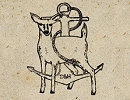Antiques for Sale | Antique Furniture | Antique Fairs | Antiques Listings | Antiques Email Alerts | Websites for Antique Dealers | Contact

Doe and Hope
Tel : +44 (0)1767 640995, Mobile: +44 (0)7729 213013
Email : info@doeandhope.com
Web : www.doeandhope.com
Web : www.antiques-atlas.com/doeandhope/
Private dealer, by appointment
The Onion Barn, Shoe Cottage
15 High Street, Blunham,
Bedfordshire, MK44 3NL.
Please don't hesitate to contact us for an appointment.
Large Decorative Italian Grotesque Painted Mirror



Description
Of impressive proportions, the painted wall mirror having a tondo plate over a larger vertical rectangular plate, the large frame with a gilded border and black ground, grotesque decorated with abstract nudes, rams heads, ribbon swags, birds, griffins and gargoyles.The mirror is in very decorative condition with the painted finish chipping and flaking back to the base surface in several areas. The plate glass has an even spread of foxing, with both plates showing good character. To the reverse there is a muslin canvas attached to the rear boards and the back panels of the mirror are pine and have no real age to them. We are undecided as to whether the back of the mirror has been replaced or if not then it is in keeping with the whole and therefore the entire commodity is of a more recent creation and made to appear mid nineteenth century in date.
This style of decoration was first seen in the fifteenth century when the grottos were discovered and then later returned to stylistically in both the late eighteenth and nineteenth centuries with Pompei. We cannot find any other examples like this mirror at all having been recently sold, antique or otherwise.
The grotesque imagery we see depicted here is reminiscent of that of decoration found in Nero’s Palace in Rome. After the fire that destroyed parts of Rome, Nero decided to appropriate some 125 acres to build a sumptuous palace and gardens, together with a lake that, according to Suetonius, resembled the sea. It was said that all parts of the palace were covered with gold. Since the building became “an embarrassment to sub-sequent emperors”, it was abandoned or at least used sparingly. Finally, the fire of 104 led Trajan to destroy the Golden Palace and build baths in its place. Halls that were not used were filled with rubble. In the 1480’s areas of the palace were rediscovered underground, as humanists picking through the rubble of ancient ruins came across openings that led them to amazing rooms, labeled caverns or grotte, with perfectly pre-served decorations. As more entrances were unearthed and more underground rooms were revealed, a procession of famous writers and painters came to observe, copy, and plunder. Giorgio Vasari explains that the works they found “were called grotesques from having been discovered in the underground grottoes and executed with so much design, with fantasies so varied and so bizarre”.
Of the same sentiment, this is wonderfully imposing, whimsical, fantastical, and extraordinary.
Date1960s :
c.960 or later
DimensionsHeight 61 inches
Width 42 inches
ConditionGood.
Codeas155a988
Price SOLD £1250.00
StatusSold
SellerDoe and Hope
Telephone07729 213013Non UK callers :+44 7729 213013 Emailinfo@doeandhope.com
Contact
Send Doe and Hope a message about this item here





